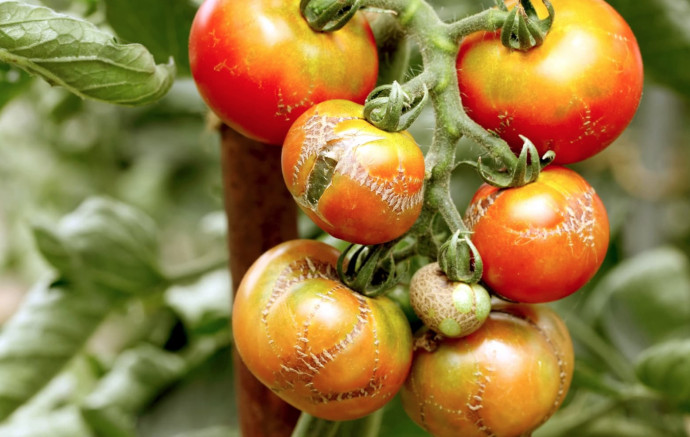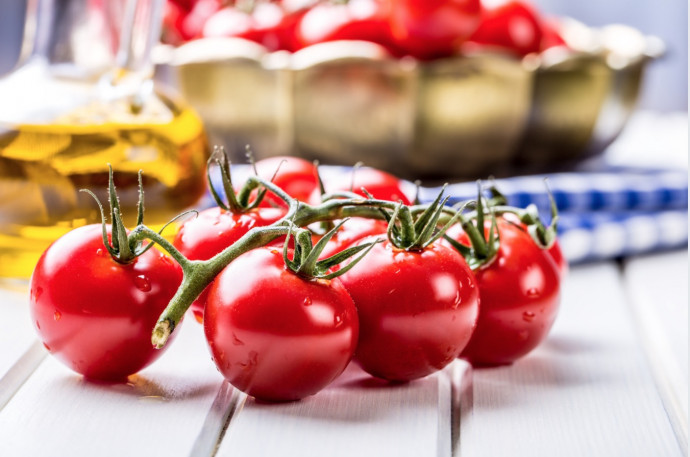1. Viral Diseases

What they look like: Viral diseases primarily affect the tomatoes themselves. You may find black spots or strange streaks on the tomatoes. Don't confuse the signs of disease with how some heirloom tomatoes look with natural streaks.
What causes them: Many of these viruses spread when plants are stressed by heat, drought, or poor soil.
What to do about them: If you've read through all of these tomato problems and think your tomatoes may be suffering from a viral disease, spray your tomato plants with neem oil. Good soil care and using organic fertilizer for tomatoes will also help keep your plants healthy, which can help them resist viruses better, of course.
2. Blossom Drop

- What it looks like: Flowers appear on your tomato plants, but they fall off without developing tomatoes.
What causes it: temperature fluctuations cause the blossoms to drop. Tomatoes need nighttime temperatures between 55 and 75 degrees F to keep their flowers. If temperatures fall outside of this range, blossom drop occurs. Other reasons for blossom drop in tomatoes include insect damage, lack of water, too much or too little nitrogen, and lack of pollination.
What to do about it: While you can't change the weather, you can make sure the rest of the plant is strong by using fertilizer for tomatoes, attracting pollinators by planting milkweed and cosmos, and using neem oil insecticides.
3. Blossom End Rot

- How it looks: The tomato plants seem healthy, but when the tomatoes ripen, an ugly black spot appears on the soil. The black spot on tomatoes looks leathery. When you try to cut the spot off to eat the tomato, the fruit inside looks mealy.
What causes this: Your plants aren't getting enough calcium. Either there is not enough calcium in the soil, or the pH is too low for the plant to absorb the calcium that is present. Tomatoes need a soil pH around 6.5 to grow properly. This soil pH also allows them to absorb calcium. Inconsistent watering habits also contribute to this problem. Hot, dry periods tend to exacerbate blossom end rot.
What to do about it: Before planting tomatoes in the spring, have your garden center or Cooperative Extension do a soil test. Tell them you've had problems with blossom end rot in the past, and they'll give you recommendations on what amendments to add to your soil. Lime and gypsum can be added for calcium, but they need to be added in the right amount depending on the condition of your soil. This is why a soil test is necessary. Adding crushed eggshells to your compost pile can also naturally increase calcium levels when you add compost to the soil. A foliar spray containing calcium chloride can prevent the development of blossom end rot on tomatoes mid-season. Apply it early in the morning or late in the day - if sprayed on leaves at midday, it can burn them. Water the plants regularly and at the same time each day to ensure an even water supply.
4. Fruit cracks

- What they look like: Cracks appear on ripe tomatoes, usually in concentric circles. Sometimes insects use the cracks as an opportunity to eat the fruit, or birds attack cracked fruit.
What causes them: Hot, rainy weather causes fruit cracks. After a long dry spell, tomatoes are thirsty. After the first heavy rain, the plants can absorb water quickly, causing the fruit to swell and crack.
What to do about it: Although you can't control the rain, you can water tomatoes evenly during the growing season. This will prevent them from becoming so thirsty that they absorb too much rainwater during a heavy downpour.
5. Sunscald

- How it looks: The plants look healthy, and the fruits are developing normally. As the tomatoes ripen, yellow spots form on the red skin. The yellow spots turn white and paper thin, resulting in an unpleasant appearance and poor taste.
Causes: As the name suggests, the sun's rays have actually scalded the tomato.
What to do about it: Tomato cages or a wire system surrounding the plants provide the best support for the branches and naturally shade the developing tomatoes. Sunburn usually occurs on pruned plants that have been over-pruned, exposing many of the tomatoes to sunlight. Leaving some leaves and branches will provide shade during the hottest part of the day.
6. Puffiness

- How it looks: The tomato plants look good, they are blooming on schedule, and the ripe red tomatoes are ready for harvest. When the tomato is cut open, the inside has large, open spaces and not much fruit inside. The tomatoes may feel light to the touch when harvested. The exterior of the tomato may have an angular, square appearance.
Causes: Underfertilization, poor soil nutrition or inadequate pollination.
What you can do about it: Make sure you feed your tomato plants throughout the season. A balanced fertilizer such as 10-10-10 should be applied bi-weekly or monthly. Tomatoes are heavy feeders and need fertilizer throughout the growing season. For gardeners, frequent top-ups with homemade compost and compost teas are a must.
7. Poor fruit set

- What it looks like: You have some blossoms, but not many tomatoes. The tomatoes you have on the plant are small or tasteless.
What causes it: too much nitrogen in the soil favours lots of green leaves, but not many blossoms. If there aren't enough flowers, there won't be enough tomatoes. Another cause may be that tomatoes are planted too close together. Tomatoes are self-pollinating, which means that each flower contains both the male (stamens) and female (pistils) parts. Normally, the wind pollinates the tomatoes, but if the plants are too close together, the wind can't reach the flowers.
What you can do about it: Have your soil tested. If you're planting tomatoes in the spring, leave at least a foot or more between plants so good air circulation can help pollination. If your plants are already in the garden, you can simply shake the flowering branches to simulate wind and move pollen from the stamens to the pistils.
8. Leaf roll

- What it looks like: Mature tomato plants suddenly curl their leaves, especially older leaves near the ground. The leaves curl in from the outside toward the center. Sometimes up to 75% of the plant is affected.
What causes it: High temperatures, wet soil and over-pruning often cause leaves to curl.
What to do about it: Although it looks ugly, leaf curl does not affect tomato development, so you will still get edible tomatoes from your plants. Avoid over-pruning and make sure the soil allows excess water to drain away.
9. Early blight

- What it looks like: You will find brown spots on the tomato leaves, starting with the older leaves. Each spot will begin to develop rings, like a bull's-eye. The leaves turn yellow around the brown spots, then the entire leaf turns brown and falls off. Eventually, the plant may have few, if any, leaves left.
What causes it. A fungus called Alternaria solani. This fungus can overwinter in the soil. So if your plants have had problems like this before, and you planted tomatoes in the exact same spot, chances are good that the same thing will happen to your plants this year.
What you can do about it: Crop rotation prevents new plants from being infected with the disease. Avoid planting tomatoes, eggplant or peppers in the same spot each year, as they can all become infected with late blight. A garden fungicide can treat infected plants.
10. Catfacing

- What it looks like: Catfacing makes tomatoes appear deformed. The blossom end is curled, bumpy and lumpy.
What causes it: Plants that are pollinated on cool evenings when temperatures are around 50 to 55 degrees are prone to catfacing. The flowers fall off when temperatures drop too low. However, if the flower is pollinated before the petals begin to fall off, some will remain attached to the developing tomato. This causes the lumps and bumps typical of catfacing.
What to do about it: If possible, plant tomatoes a little later in the season. Make sure the weather has really warmed up enough to support good tomato development. Devices like a "Wall of Water" - a circle of water-filled plastic tubing -will raise temperatures near the tomato and help keep them high enough on cold nights to avoid cold-related problems. Using black plastic spread on the ground can also help. As the plastic heats up during the day, it releases the heat back to the plants at night. Black plastic can be used as a temporary measure until temperatures warm enough that it is no longer needed. Cat-faced tomatoes are safe to eat; just cut away the scarred areas.











